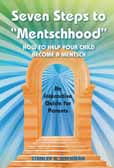Seven Steps to “Mentschhood”—How to Help your Child Become a Mentsch: An Interactive Guide for Parents
 Seven Steps to “Mentschhood”—How to Help your Child Become a Mentsch: An Interactive Guide for Parents
Seven Steps to “Mentschhood”—How to Help your Child Become a Mentsch: An Interactive Guide for Parents
By Stanley H. Fischman
Penina Press
Jerusalem, 2012
144 pages
Reviewed by Yaakov Bieler
One of the universally acknowledged goals of Jewish education, in addition to acquainting students with the fundamentals of Judaism, deepening their sense of faith and commitment to religious life, equipping them with the skills that will allow them to become life-long learners and preparing them to continue their Jewish and secular educations is the development of exemplary character traits, often represented by the Yiddish term “Mentschlichkeit,” or in Stanley Fischman’s more Americanized form, “Mentschhood.” One would have hoped that serious engagement with Tanach, Talmud, halachah and hashkafah over the course of twelve-plus years of synagogue attendance, day school education, and youth group and summer camp participation would virtually guarantee a young person’s character refinement. Unfortunately, at least anecdotal evidence does not seem to bear this out. Therefore, volumes like Seven Steps to “Mentschood” have been eagerly sought out by parents and teachers in search of orderly, cogent approaches for improving their children’s and students’ middot.
Fischman, a Jewish educator for four decades who is currently the director of general studies at Ben Porat Yosef in Paramus, New Jersey, bases his book on conversations between parents and children regarding behaviors observed and engaged in primarily within the school context. The steps themselves are structured along the lines of Rabbi Pinchas ben Yair’s program for spiritual development outlined in Avodah Zara 20b, which in turn serves as the basis of Ramchal’s mussar classic Mesilat Yesharim. The seven steps are arranged sequentially, from the easiest to the most difficult, each level keyed upon a phrase drawn from Tanach: 1. “You shall love your fellow man as yourself” (Vayikra 19:18); 2. “You shall not hate your brother in your heart” (ibid. 17); 3. “And you shall not place a stumbling block before the blind” (ibid. 14); 4. “Open your hand to your brother, to your poor and to the needy in your land” (Devarim 15:11); 5. “You shall do what is right and good in the eyes of Hashem” (ibid. 6:18); 6. “The Ways of the Torah are ways of pleasantness and all its pathways are peace” (Mishlei 3:17); 7. “You shall be holy” (Vayikra 19:2).
The author not only expects a family to discuss each step (i.e., the Torah interpretations associated with each stage along with relevant mitzvot, anecdotes, poems and parallel passages from Pirkei Avot), but also to discuss behaviors in school that either conform or do not conform to the various steps. By calling attention to each step’s real-world (the author emphasizes that for children, school constitutes their “real world”) manifestations, parents and children are afforded the opportunity to reflect upon concrete applications that can either be reinforced or critiqued in a practical manner.
Fischman’s book is commendable in terms of setting forth an organized, rational middot program that every family should be able to incorporate in its day-to-day activities, provided, of course, that it is motivated to do so. I wonder if at least a part of the challenge for implementing such an approach will be what so many educators encounter with respect to parental involvement i.e., that specifically those children who are often most in need of their parents’ active participation in the educational process are the ones who are not afforded it due to their parents’ limited time, their feelings of inadequacy with respect to their own educations, family and work challenges, et cetera.
Furthermore, the author emphasizes how important parents’ modeling exemplary middot and behavior is for their offspring’s character development. While children are captive audiences vis-a-vis their parents and schools, and can be required to engage in all sorts of projects and activities, the adults in these contexts are free agents, setting their own agendas with respect to their interests, priorities and behaviors. Fischman does not discuss or present any sort of plan whereby parents and teachers will also be able to engage in their own character development and refinement as part of an overall program that will not only help their children and students, but also ultimately themselves.
Finally, the subtitle “How to Help Your Child Become a Mentsch” is slightly misleading. While the author certainly presents a sophisticated, comprehensive and well-thought-out approach to middot development, the volume is clearly geared to the elementary school student. Right at the outset, the author states, “[The program] was developed in fourth-grade classrooms over a period of about ten years.” While younger children are certainly impressionable and excessively delaying trying to positively influence their character development would not be ideal, an effective program has to extend throughout the school years and beyond in order to address a child’s changing needs, developmental stages, identity crises and the like. I would hope that Seven Steps to “Mentschood” will spawn additional volumes that will reflect how a middot refinement program is an important lifetime undertaking that should not be left to chance.
Rabbi Yaakov Bieler is the rabbi of the Kemp Mill Synagogue in Silver Spring, Maryland. He has lectured and written extensively on the philosophy of Jewish education and worked in day schools for over thirty years.
Listen to an interview with author Stanley Fischman at http://www.ou.org/life/series /savitsky-talks/
